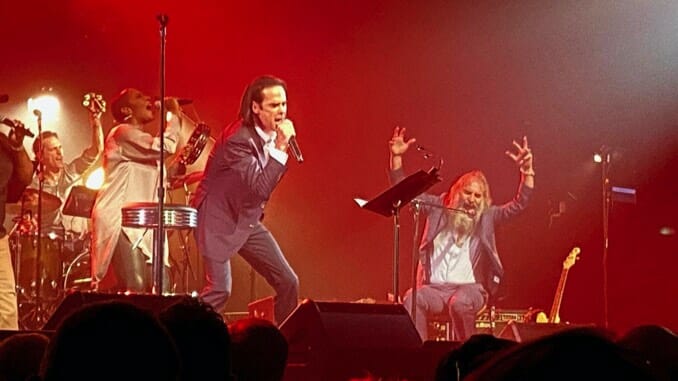Notes on the Nick Cave & Warren Ellis North American Tour
Photo by Palma Sabina
Let me start by saying that I have never written about a concert before, and I don’t typically write about music. I am primarily a film and entertainment writer, though I understand that “entertainment” can include music, sure. But only very recently have I begun to dabble in music writing at all. The fact is that most of the writing on music that I ever do has been in relationship to film or it’s been about Nick Cave.
As many of my friends and close acquaintances know—and are surely tired of hearing about—I got into Nick Cave last July, after watching Wim Wenders’ Wings of Desire. In the 1987 film starring Bruno Ganz, where Ganz portrays an angel from heaven who watches over the people of Earth, growing fondness for them until he wishes to become human, Nick Cave functions as a strange, connective tissue. Cave’s music is first played diegetically by a character, and then, later on, we witness a real live performance by Cave and his band, Nick Cave and The Bad Seeds. At the time I watched the film, I knew Nick Cave like anyone knows the name of a famous artist through pure internalized sublimation of pop culture, a very imprecise awareness granted just by being someone interested in entertainment and art. I was mostly familiar with him through his (arguably most famous) song, “Red Right Hand,” which I had downloaded at one point onto my iPod Classic, and I’ve listened to it frequently. I knew what Nick Cave looked like, I knew the name of his band, but I didn’t know any of his other music or anything else he’d done. Yet when Solveig Dommartin’s character, Marion, played the Bad Seeds’ album From Her to Eternity on her record player, and Cave’s haunting cadence recited the lyrics to “The Carny,” I instantly asked myself, “Is that Nick Cave? I think that’s Nick Cave.” I barely knew this artist, yet, somehow, I just sort of knew it was him.
And when Cave and his band appeared as themselves in their performance towards the end of the film, I was instantly spellbound. Cave has a peerless presence. He is ghoulish and towering and impenetrably handsome; his voice can vacillate between eldritch howls and Gregorian intonations of spoken word, all sustained by an innate sexuality that is inseparable from his music even when he’s singing about lecherous perverts and killers. He emerges in the film like an alluring angel of death, with his rail-thin, gangly build and signature loose, slicked-back black hair, which he maintains even as he now fast approaches his mid-60s. Cave’s was not the kind of music I typically listened to. Since I spent high school forcing myself to believe that I actually enjoyed the sounds of pop-punk, hardcore and “screamo” music like my group of friends did, I had, in some sort of subconscious act of self-defiance, geared myself almost exclusively in the opposite genre direction post-graduation. After years of forcing myself to listen to music that I didn’t really think sounded very pleasant, I only wanted to listen to music that was the utmost palatably catchy.
I had also not been to a concert since long before the COVID-19 pandemic. The last one I attended was Tyler, The Creator in Lancaster, Pennsylvania, back in 2017. It feels like a weird thing to admit, but as I got older, I simply fell out of touch with music. I became committed to music that only elicited simplistic, pleasant emotions out of me and, thus, I lost interest in seeing any artists who I enjoyed perform live because I no longer had any passion for them. Not to be annoying, but something shifted in me when I started listening to Nick Cave. My relationship to music changed—my perspective on what music could do for me changed. I still listen to catchy, palatable pop music, to be clear. I openly love Taylor Swift, and Doja Cat, and Dua Lipa, and Lana Del Rey—and not in any sort of “guilty pleasure” sense, either. I listen to them as often as I do Nick Cave. But I fell deeply in love with Cave’s music and various other works last year in a capacity I had not experienced before with music or any art, really, further enhanced by the way Cave’s presence as a pop-cultural figure is closely linked to cinema. Between his multiple bands, film scores, screenplays, documentaries, and novels both written by him and about him, I became somewhat insufferably obsessed with him. But I truly feel like my life became better in being exposed to Nick Cave’s art.
Here we finally arrive at the Nick Cave & Warren Ellis North American tour, which I attended on the evening of Thursday, March 24, at Kings Theater in Brooklyn. After painstakingly following along with Cave and Ellis’ European tour during fall 2021 via Instagram at the height of my obsession, and waiting with an increased sense of urgency for them to finally post North American dates, I snatched up a ticket for myself and my friend as soon as they became available back in November. They were not the most expensive tickets in the world, especially in comparison to how much I know concert tickets can cost. But as someone who frequented shows on a rolling basis during high school and college, it was the most money I had ever spent on concert tickets before.
-

-

-

-

-

-

-

-

-

-

-

-

-

-

-

-

-

-

-

-

-

-

-

-

-

-

-

-

-

-

-

-

-

-

-

-

-

-

-

-








































